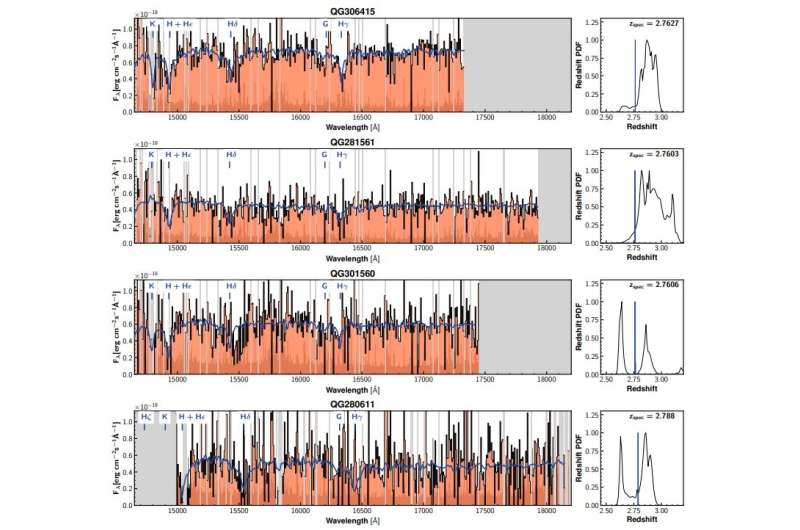January 31, 2023 report
This article has been reviewed according to Science X's editorial process and policies. Editors have highlighted the following attributes while ensuring the content's credibility:
fact-checked
preprint
trusted source
proofread
New protocluster of massive quiescent galaxies discovered

An international team of astronomers reports the detection of a new protocluster of galaxies. The newfound protocluster, designated QO-1000, contains at least 14 massive quiescent galaxies. The finding was detailed in a paper published January 21 on the arXiv pre-print server.
Galaxy clusters contain from hundreds to thousands of galaxies bound together by gravity. They are the largest known gravitationally bound structures in the universe, and could serve as excellent laboratories for studying galaxy evolution and cosmology.
Astronomers are especially interested in studies of protoclusters of galaxies, the progenitors of clusters. Such objects, found at high redshifts (over 2.0), could provide essential information about the universe at its early stages.
Now, a new high-redshift protocluster has been found by a group of astronomers led by Kei Ito of the University of Tokyo, Japan. The discovery is a result of an analysis of the data from the Cosmic Evolution Survey (COSMOS) and spectroscopic observations using the Keck I telescope.
"We search overdense structures of quiescent galaxies at z ∼ 3 in the COSMOS field in ∼ 2 deg2 based on the projected distribution of quiescent galaxies," the researchers explained.
In result, they found such an overdensity of 14 quiescent galaxies at a redshift of 2.77. The protocluster, which received designation QO-1000, includes four massive galaxies with low specific star formation rates. The results suggest that this structure is at least 68 times denser in quiescent galaxies than in the general field and that its quiescent fraction is about three times higher than the average value at this redshift.
The astronomers noted that the high stellar mass of spectroscopically confirmed quiescent galaxies of QO-1000 indicates they are hosted in a massive halo. They added that the structure is likely to be hosted by a much more massive halo than the other typical quiescent galaxies with the same stellar mass.
The researchers assume that QO-1000 is therefore a more mature protocluster than most known protoclusters and is likely in a transition phase from star-forming protoclusters to local quenched clusters. According to the authors of the paper, their finding proves that even at a redshift of almost 3.0, protocluster galaxies can be quenched, and quiescent galaxies can form an overdense structure. They hope that further studies of QO-1000 will help us advance our knowledge regarding the evolution of protoclusters.
"This structure will be an ideal laboratory to explore the evolutionary history of (proto)clusters and galaxies therein. More detailed investigations of member quiescent galaxies in this structure will be conducted in our future studies, such as constraining star formation history based on the spectra and multi-band photometry, investigating morphology using HST/F160W images (3D-DASH Mowla et al. 2022), estimating dynamical mass, and comparing them with simulations," the scientists concluded.
More information: Kei Ito et al, COSMOS2020: Discovery of a protocluster of massive quiescent galaxies at z = 2.77, arXiv (2023). DOI: 10.48550/arxiv.2301.08845
Journal information: arXiv
© 2023 Science X Network





















